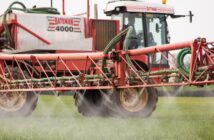The next five to 10 years will bring unprecedented change to the farming industry, and while there are many issues that farmers can’t control, there is plenty they can do to prepare.
According to speakers at the Cereals Event on Wednesday (13 June), the outlook may be almost as uncertain as it was at the time of the Brexit vote, but there are also plenty of opportunities ahead. “We are going to see things evolve over the next five years that we haven’t even dreamed about,” said Allan Wilkinson, head of agriculture at HSBC. “The opportunities are immense.”
However, it is vital that farmers engage with MPs and get involved in shaping future policy, added Minette Batters, president of the NFU. “Food security has to be taken more seriously – Michael Gove is a big hitting politician and he can really make a difference, but we need a new deal.”
According to Peter Kendall, chairman of AHDB, the arable industry is enjoying a honeymoon period before Brexit, with access to support payments and EU markets, and reasonable grain prices. Now is therefore the time to act and prepare for future change by coming together, sharing knowledge, and being ambitious.
“All possible outcomes of Brexit are going to change our business environment,” explained Martin Grantley-Smith, AHDB Cereals & Oilseeds’ strategy director. To prepare for that, farmers need to understand their business and costs of production, and have access to the right information to make good decisions.
AHDB is making it easier for farmers to access that information through its demonstration farm network, but according to Oxfordshire farmer James Price it’s also important to actively seek it out and to build closer links to shorten the supply chain. “We can’t expect the answers to be given to us, we have to go out and find them.”
Host farmer Robert Law is focusing on reducing risk within his business, and said it’s important to produce budgets based on income without a future single payment. His farm manager, David Hurst, agreed. “We’ve got to be ready to react – get your ducks in a row for when the opportunity comes. Direct payments have stifled innovation and there are probably a lot of lazy businesses out there.”
With so many external changes going on – which farmers can’t control – it’s vital that they act to improve profitability now, warned Jeremy Moody, secretary and adviser to the Central Association of Agricultural Valuers. “Why defer being better? By the time we reach the mid 2020s there will be other changes to be paralysed by.”
In open market circumstances, businesses will have to be extremely flexible and reactive, to make the most profitable use of their land and assets. “The wider the spread of income sources you have the greater your financial resilience,” said Mr Moody. “However, that could possibly be at the cost of business focus.”
Land use and occupation is likely to change markedly, opening up opportunities for new entrants and new ventures, he added. “In the UK subsidies have resulted in stasis in farm occupation. It’s been a means to subsidise loss-making production.”
New technology will drive huge changes in the industry – perhaps it will not be as significant as the shift from horse power to tractors, but it will happen faster, predicted Mr Moody. “The amount of change in the next 10 years will be pretty formidable.”
There was plenty of new technology on offer at the Event, from cutting-edge precision machinery to novel plant breeding and genetic research. Newcastle University unveiled a new blackgrass resistance diagnostic test at the Event, designed to quickly highlight blackgrass resistance in crops. It works by measuring a specific protein which regulates resistance, and allows growers to instantly adapt their management strategy.
“Blackgrass is the number one problem for wheat producers, estimated to cost around £0.5bn a year,” said head of agriculture Professor Robert Edwards. “We’ve been working on this project for 20 years but in the last 4-5 years we’ve made significant progress. This technology works similarly to a pregnancy test and gives results within 10 minutes. It’s a world first, and is a means of monitoring whether resistance is travelling in the right direction.”




